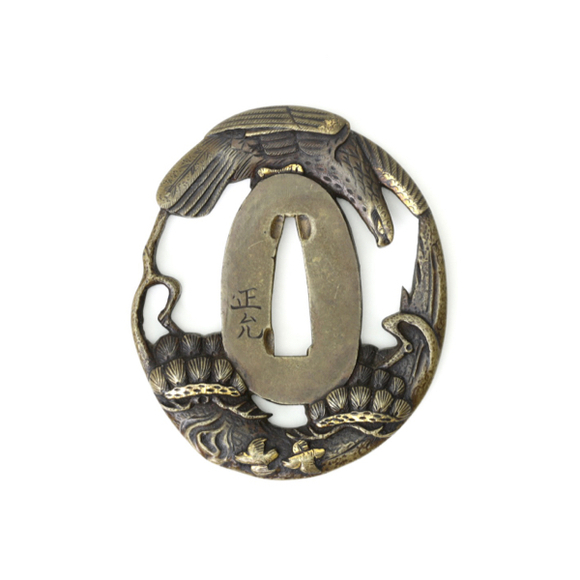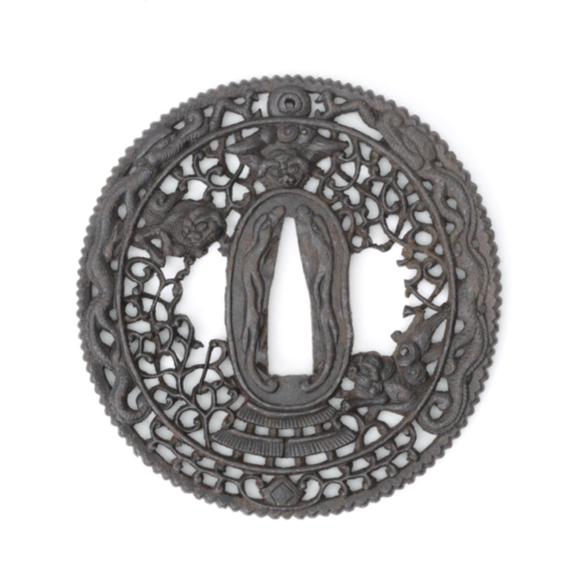Russet iron, one-piece construction with decorative grooves.

Blade 36.2 cm
Nagasa 25.6 cm
Base 4.8 mm
Tip 3.4 mm
Base 26.8 mm
138 grams
Tempered steel
Kuwana, Ise, Japan
Aoi Art, Japan
Introduction
Every Japanese household will know of at least two master swordsmiths, Masamune and Muramasa.
Masamune lived from circa 1264–1343 AD and is widely regarded as Japan's best smith, renowned for tempering blades fully covered in brilliant nie crystals, combined with a certain nonchalance in his hamon and hada that appeals to the Japanese appreciation of wabi-sabi.
Muramasa was a smith working in Kuwana, Ise province, dubbed the "Land of the Gods." He was renowned for his extremely sharp and durable blades, which were used by many notable samurai. The Sengoku period in which he was active was marked by over a century of intense civil war between warlords competing for supremacy over Japan.
There were actually several generations of Muramasa, of which the 2nd generation was the most famous, skillful, and prolific. However, some experts like Fujishiro have stated that the differences between these two generations are small enough to support the theory that this was, in fact, a single person who reached mastery at the end of a rather long active career.1
Notes
1. Fujishiro Matsuo; Nihon Token Jiten, Koto Hen. 1974.
Workmanship
There is a mix of Sōshū and Mino style bladesmithing paired with some unusual features. The nakago (tang) is of the distinct tanagobara "grasshopper's belly" form which is unique to his school, with kengyō or iriyamagata-jiri (V-shaped end).
Muramasa usually forged a fine itame hada with masame. He tempered in a variety of styles, including suguha and hitatsura, but the most characteristic is Muramasa's hako-midare with square-ish elements and very low valleys where the temperline almost reaches to the very edge.
Unique to Muramasa is the aim to create perfect symmetry in an undulating hamon. This can only be achieved when the forge folded body of the blade is extremely uniform in composition, so in a way, their symmetrical hamon are a testament tot the quality of their steel purification techniques.
Fujishiro rated Muramasa saijō-saku; grandmaster level.
For more, see my glossary article: Muramasa (村正)
The Curse of Muramasa
Today, the incredible workmanship that brought Muramasa to fame is overshadowed by the legends of a curse that would upon his blades. The idea of a curse was based on a series of unfortunate events that befell the family of Tokugawa Ieyasu, the powerful warlord who was to become the first shōgun to rule all of Japan.
In 1535, the grandfather of Ieyasu was killed by one of his own men. His body was severed from shoulder to hip with a Muramasa katana. In 1545, Ieyasu's father is stabbed with a Muramasa tantō. Again by one of his own men. In 1550 young Ieyasu cut himself badly while playing with a small knife by Muramasa.
In 1579 Ieyasu is forced to order his eldest son to commit seppuku, a ritual suicide by self-disembowelment followed by decapitation by a second man. Ieyasu found out after the fact that the blade used was a Muramasa. The family annals note he couldn't believe it was another Muramasa, and grew wary of them.
1600, after the conclusion of the battle of Sekigahara that consolidated Ieyasu's rule, he inspected a spear that had pierced the helmet of an enemy general. He accidentally cut himself and and half-jokingly said: "This must be a Muramasa." And it was...
You'll understand that Muramasa blades really did give Ieyasu the creeps, and he banned them. He did, however, keep his own katana by Muramasa, a rare hitatsura-tempered sword, which is still in the Tokugawa family today.
Meanwhile, wild stories of cursed Muramasa blades spun out of control. Popular culture in the form of pulp literature and Kabuki plays had the people believe they were made by a wicked smith who worked with oni (demons) and that the swords lead their owners to frenzy.

A Tale of Sano Jirōzaemon, Tsukioka Yoshitoshi, 1886.
Los Angeles County Museum of Art, accession number M.84.31.539a-b.
Based on the true event of a samurai murdering prostitutes in Edo's Red Light district.
In the story, it was his Muramasa sword that led him to the act.
In one version of a famous tale, Muramasa is Masamune's student. One day Muramasa challenges his master who makes the best blades. They both forge a masterpiece and put the swords in a river. Muramasa's blade cuts everything in its path: leaves, fish. Masamune's blade, however, cuts only leaves. A monk who witnesses the spectacle proclaims Masamune as the winner, because Muramasa's blade kills indiscriminately and Masamune's blades don't cut the undeserving.
Also see: The Curse of Muramasa, a historical overview.
This example
A fine tantō by Muramasa, which shows the typical work of what is widely regarded to be the 2nd generation. The blade has the mitsu-mune that was so often used by the Sōshū masters, most notably Masamune and Sadamune, and clearly is a nod towards them.
The hamon is of the flamboyant, aggressive style that marks this Muramasa's most notable works. A hako-midare that reaches high with very deep valleys almost reaching the edge. Some chojī elements form sanbonsugi ("three pines"), an influence he most likely picked up from 2nd generation Kanemoto, a.k.a. "No-Sada", one of the best Sue-Seki smiths who at some point also worked in Ise, and was most likely an acquaintance of Muramasa.
Notes
We know that No-Sada had also worked in Ise at some point.
There exists a sword signed: Ise ni oite Yamada kore o saku
(於伊勢山田是作) “made in Ise ́s Yamada”.
See: Markus Sesko: Swordsmiths of Japan. Lulu Publishing, 2015. Page 730.

Sword attributes
(With plain English below)
Nakago: Ubu. Tanagobara with iriyamagata-jiri with slight katte-sagari yasurime. Nijimei. One mekugi ana.
(Tang: Unaltered. "Grasshopper's belly" with asymmetrical V-shaped end. Finished with slightly slanting file marks from upper left to lower right. Two-character signature. One peg hole.)
Sugata: Hira-zukuri with wide mihaba. Mitsu mune.
(Overall form: Blade with flat sides and relatively wide base. Spine finished with three facets.)
Jigane: Mainly a fine masame with some itame-hada.
(Steel: Mainly straight grain with some more irregular small wood grain patches.)
Hamon: Haku-midare in nioi-deki with sanbonsugi elements. One slanting patch of yubashiri on the same place on either side. Hamon runs symmetrically on both sides.
(Temperline: Box-like undulating hamon with formations of three peaks. One slanting patch of nie crystals that appears outside the temperline. Identical on both sides.
Boshi: Ko-maru with long kaeri. Tending towards jizō.
(Temperline at tip: small circle turning point with long temperline along the back. Tending towards a shape that resembles the Bodhisattva jizō as seen in profile.)
Tanobe-sensei sayagaki
This is a masterpiece by this smith, but don't take my word on it. Tanobe-sensei, whose opinion is perhaps the most highly regarded in the world of Japanese swords, wrote it on the saya:

勢刕村正
タナゴ腹デ棟ヲ角・刃方ヲ小肉ニ仕立テル茎ニ軽妙ナ二字銘ヲ有シ二代也 刃⻑八寸四分半
癸卯清和月探山識「花押」
Seishū Muramasa
Tanagobara de mune o kaku, hagata o ko-niku ni shitateru nakago ni keimyō na niji-mei o yūshi nidai nari. Hachō hassun yon-bu han.
Mizunoe-u seiwazuki.
Tanzan shirusu + kaō
Translation by Markus Sesko:
"Muramasa from Ise Province
The tang is finished in tanagobara shape with a flat back and a little roundness along the cutting edge side,
which reflects with the facile and light manner the signature is executed the hand of the second generation.
Blade length ~ 25.6 cm"
"Written by Tanzan [Tanobe Michihiro] in April of the year of the hare (2023) + monogram."

孫六兼元ニモ近似スル三本杉ヲ大模様ニ焼キタル感ノ乱ニ箱刃風ヲ交ヘテ表裏ノ
刃ガ揃ヒ且ツ 山ト谷ノ起伏ガ顕著デアルナド銘字ト共ニ二代ノ典型ヲ示ス優品也
Magoroku Kanemoto ni mo kinji-suru sanbonsugi o ō-moyō ni yakitaru kan no midare ni hakoba-fū o majiete hyōri no ha ga soroi katsu yama to tani no kifuku ga kencho de aru nado meiji to tomo ni nidai no tenkei o shimesu yūhin nari.
Translation by Markus Sesko:
The blade is hardened in a relatively large dimensioned midare that is mixed with box-like hako elements and also with sanbonsugi sections that bear semblance to Magoroku Kanemoto. The ha appears identical on both sides and is noticeably undulating, an approach that may be equaled with mountains and valleys. Thus, we have here a masterwork that is typical for the second-generation Muramasa."
Habaki
It comes with a nice, two-piece gold foil-covered habaki.


Koshirae
The Muramasa came with a fine set of tantō koshirae. It is a good fit, but probably a later marriage. It is, however of very fine quality.

The scabbard is lacquered with brown and gold urushi. The hilt is made of wood, covered with ray skin that was wrapped with copper-colored silk.
All mounts are executed with the finest quality nanako that looks like the work of the Yoshioka group. It is hard to imagine this work was done with a tiny stamp, precisely hammered each time with exactly the same force.

It also comes with a matching set of kōgai and kozuka.

The scabbard endpiece is not a perfect fit, I expect the scabbard was once shortened. It is of the same style as the rest of the mounts, including the fine nanako, and so is likely the original.


Ginko mon
The fuchi, kashira, both menuki and the kōgai and kozuka carry a peculiar mon I have not been able to find in the reference books. It appears to be a stylized ginko leaf. Ginko trees are associated with longevity and were often planted on temple grounds.
Probably unrelated, but there is a famous ginko tree in at the Tsurugaoka Hachiman-gū's shrine in the city of Kamakura. The tree is nicknamed kakure-ichō (hiding ginkgo), because of a legend in which shōgun Minamoto no Sanetomo was assassinated by his nephew, who had ambushed him from behind the tree.




















Unusual tsuba with foreign figures and Chinese auspicious symbols.






